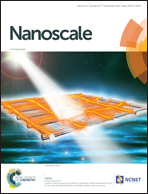Robust half-metallicity in transition metal tribromide nanowires†
Abstract
One-dimensional (1D) nanowires (NWs) with robust half-metallicity are a rising star in spintronics. Herein, we theoretically investigate the magnetic and electronic properties of 3d transition-metal tribromide NWs, i.e. TMBr3 (TM = Sc, Ti, V, Cr, Co, and Cu). These systems represent repeated TMBr3 motifs with octahedral configuration, and are expected to be synthesized in a nanotube using an established method. Among these NWs, both VBr3 and CuBr3 NWs exhibit a ferromagnetic (FM) ground state, accompanied by sizable magnetocrystalline anisotropic energy, which is dominated by the superexchange coupling between the TM atoms. Strikingly, a half-metallic nature with a magnetic moment of 4.0μB per unit cell is predicted for the VBr3 NW. By combining with a tight-binding model, we demonstrate that the origin behind the half-metallicity is the half-filled e2 orbitals of the V atoms. The Curie temperature is evaluated to be up to 80 K using Monte Carlo simulations, which is comparable to the temperature of liquid nitrogen. We also find that the half-metallic behavior shows a favorable tolerance to the longitudinal elongation of the wire (∼10%). Additionally, a transition from FM semiconductor to half-metal can be realized in the CuBr3 NW through carrier doping. The coexistence of intrinsic high-temperature FM ordering and half-metallicity endows 1D TMBr3 NWs with great promise for spintronic and photoelectron device applications.



 Please wait while we load your content...
Please wait while we load your content...